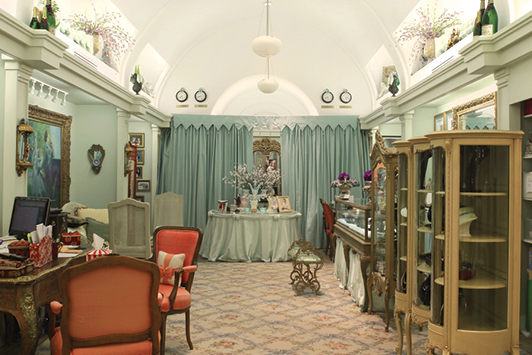
“Show me the diamonds, the gold, the platinum — there is always going to be a market for estate jewelry,” says Tobina Kahn. “Not only is it chic to wear, but there is more value in purchasing estate jewelry than in buying brand-new merchandise.”
Kahn is president of House of Kahn Estate Jewelers, which her parents, Adele and Edward Kahn, founded more than 50 years ago. The company has two stores — one in Chicago, Illinois, and one in Palm Beach, Florida.
“I’ve always loved jewelry,” she says. Over the last 15 years, she has observed a greater interest in previously owned jewelry, which she attributes to a combination of factors, including lifestyle changes. More importantly, she stresses, people are living longer, and as a result, they are downsizing and selling their jewelry.
“It is not only to provide money for living expenses, but perhaps to travel the world or pay for a grandchild’s education,” she points out, adding, “Jewelry is purchased from all generations. We’ve also noticed throughout the years that what the first generation loves, the second generation dislikes. Their lifestyles have become more and more casual.”
For buyers, estate jewelry offers the value they cannot get in a high-end department store with its “excessive markup,” or a jewelry store that packages expensive pieces in “a pretty box,” Kahn says. “People buying in the secondary estate jewelry market can get a unique piece with larger stones. It really is one-of-a-kind; I can’t get the stock keeping unit (SKU) number and order another one. For people thinking ahead, estate jewelry is a viable investment whose worth will increase over the years.”
Kahn, who does her own acid testing “the old-fashioned way” to determine the purity of the metals in the pieces she sells, looks for “craftsman, high-quality jewelry that is not machine-made.” She understands that people want “the biggest bang for their buck,” but she injects a note of caution and realism: “We have customers who have no idea of the worth of pieces that may have been stored away. On the other hand, people expect to get the jewelry’s appraised amount, which is often significantly lower than its cash value. Our goal is to educate, explain and deliver the best possible price to all customers.”
The Chicago and Palm Beach stores cater to very different lifestyles, and the merchandise they carry reflects the demand of their respective patrons, according to Kahn. The Chicago customer wants jewelry she can wear from day to night to match her professional but more casual lifestyle. In Palm Beach, however, where the customers are often retired, “they’ve been there, done that. They want jewelry to match their lavish lifestyle, so we sell 4-carat, 5-carat and bigger diamonds. And dangling earrings are popular — the perfect accessory for their evening gowns,” Kahn says. The merchandise in both stores ranges from $100 to over $100,000.
Obtaining authentic, signed pieces is difficult, notes Kahn, who has sold jewelry from Cartier, Tiffany & Co. and Van Cleef & Arpels. Floral pins are among what she calls her “showstopper” pieces, especially those with invisible settings that make the flowers seem to “duplicate nature.” Some of her favorite celebrity pieces include a silver cigarette case signed by Nancy and Ronald Reagan and owned by former senator George Murphy of California; the engagement ring that actress Terry Moore received from the late Howard Hughes; and the substantial cufflink collection of Raymond Burr, the actor who gained fame playing Perry Mason.
Kahn sees a trend for natural stones, especially yellow diamonds and gemstones such as sapphires that have not been heat-treated. The coral-and-diamond and turquoise-and-diamond combinations of the 1960s are gaining popularity as well.
Most of Kahn’s customers come through referrals or are generations of families that have shopped in Chicago and Palm Beach. “I love when people bring me their jewelry box,” she says. “I promise I can find value, even if not in every single piece. If we offer more than they ever thought it was worth — that’s value. When we sell it, someone else gets a fabulous deal. And when both sides are happy, it’s a great day for us, too.”
Image: House of Kahn Estate Jewelers.Article from the Rapaport Magazine - October 2017. To subscribe click here.